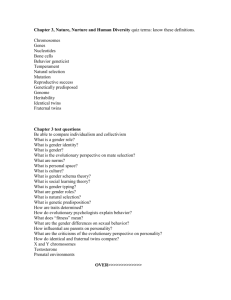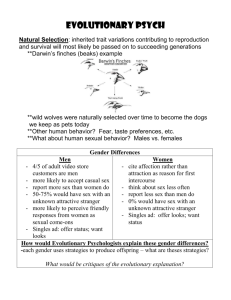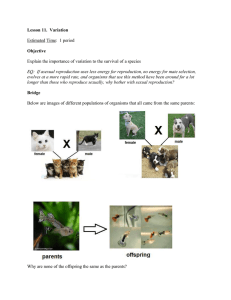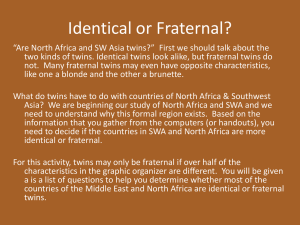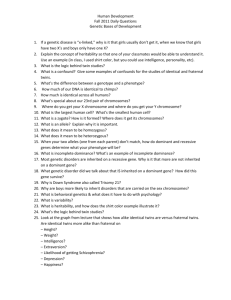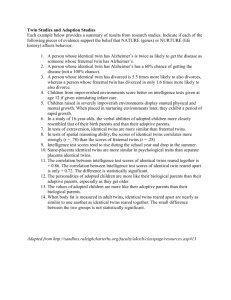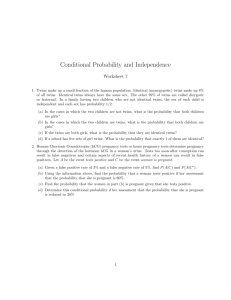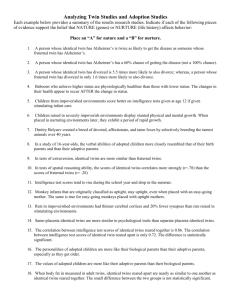Chapter 3 Practice Test
advertisement
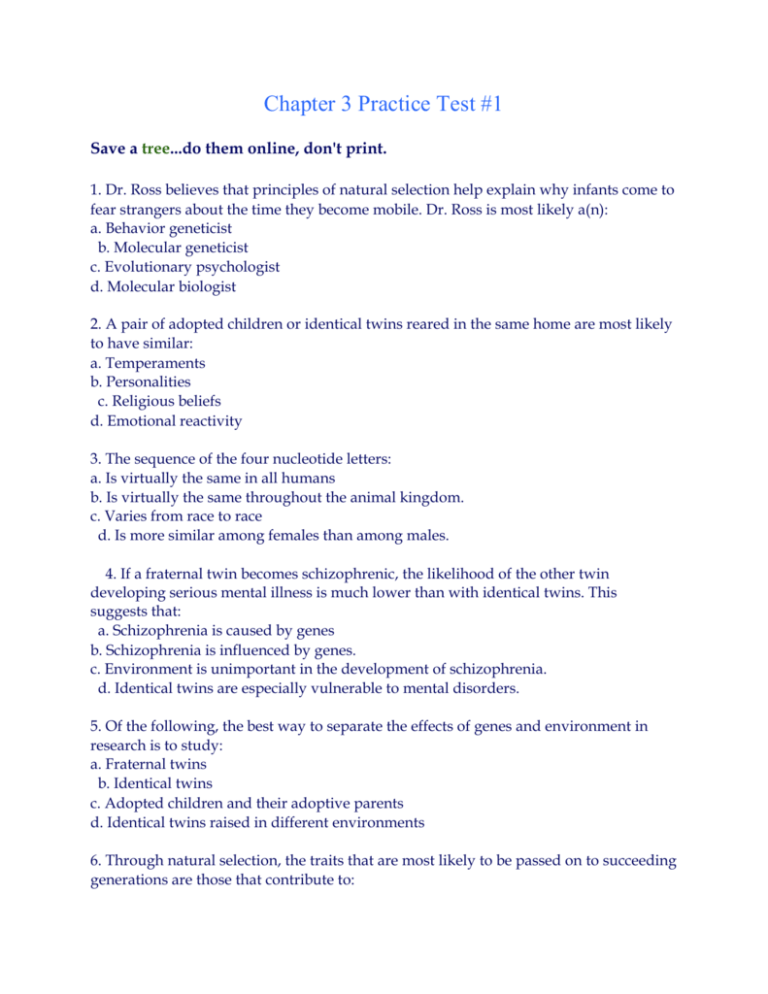
Chapter 3 Practice Test #1 Save a tree...do them online, don't print. 1. Dr. Ross believes that principles of natural selection help explain why infants come to fear strangers about the time they become mobile. Dr. Ross is most likely a(n): a. Behavior geneticist b. Molecular geneticist c. Evolutionary psychologist d. Molecular biologist 2. A pair of adopted children or identical twins reared in the same home are most likely to have similar: a. Temperaments b. Personalities c. Religious beliefs d. Emotional reactivity 3. The sequence of the four nucleotide letters: a. Is virtually the same in all humans b. Is virtually the same throughout the animal kingdom. c. Varies from race to race d. Is more similar among females than among males. 4. If a fraternal twin becomes schizophrenic, the likelihood of the other twin developing serious mental illness is much lower than with identical twins. This suggests that: a. Schizophrenia is caused by genes b. Schizophrenia is influenced by genes. c. Environment is unimportant in the development of schizophrenia. d. Identical twins are especially vulnerable to mental disorders. 5. Of the following, the best way to separate the effects of genes and environment in research is to study: a. Fraternal twins b. Identical twins c. Adopted children and their adoptive parents d. Identical twins raised in different environments 6. Through natural selection, the traits that are most likely to be passed on to succeeding generations are those that contribute to: a. Reproduction b. Survival c. Aggressiveness d. a and b e. a, b, and c 7. Which of the following is not true regarding gender and sexuality? a. Men more often than women attribute a woman's friendliness to sexual interest b. Women are more likely than men to cite affection as a reason for first intercourse. c. Men are more likely than females to initiate sexual activity d. Gender differences in sexuality are noticeably absent among gay men and lesbian women. 8. Evolutionary psychologists attribute gender differences in sexuality to the fact that women have: a. Greater reproductive potential than do men b. Lower reproductive potential than do men c. Weaker sex drives than men d. Stronger sex drives than men 9. According to evolutionary psychology, men are drawn sexually to women who seem _________, while women are also attracted to men who seem ____________. a. Nurturing; youthful b. Youthful and fertile; mature and affluent c. Slender; muscular d. Exciting; dominant 10. Unlike __________ twins, who develop from a single fertilized egg, _________ twins develop from separate fertilized eggs. a. Fraternal; identical b. Identical; fraternal c. Placental; nonplacental d. Nonplacental; placental 11. Temperament refers to a person's characteristics: a. Emotional reactivity and intensity b. Attitudes c. Behaviors d. Role-based traits 12. Compared to infants of European descent, infants of Asian descent tend to be: a. More spontaneous b. Fearless and uninhibited c. More strongly attached to their caregivers d. Calmer and less reactive 13. In a hypothetical world where all schools are of uniform quality, all families equally loving, and all neighborhoods equally healthy, the heritability of person-to-person differences would be: a. Large b. Small c. Zero d. Unpredictable 14. The subfield that studies the specific genes that influence behavior is: a. Behavior genetics b. Molecular genetics c. Evolutionary psychology d. Memes analysis 15. Which of the following most accurately expresses the extent of parental influence on personality? a. It is more extensive than most people believe. b. It is weaker today than in the past. c. It is more limited than popular psychology supposes d. It is almost completely unpredictable. 16. Gender refers to: a. The biological and social definition of male and female b. The biological definition of male and female. c. One's sense of being male or female d. The extent to which one exhibits traditionally male or female traits 17. The fertilized egg will develop into a boy if, at conception: a. The sperm contributes an X chromosome. b. The sperm contributes a Y chromosome. c. The egg contributes an X chromosome. d. The egg contributes a Y chromosome. 18. Which theory states that gender becomes a lens through which children view their experiences? a. Social learning theory b. Vygotsky's sociocultural theory c. Piaget's theory d. Gender schema theory 19. The hormone testosterone: a. Is found only in females. b. Determines the sex of the developing person. c. Stimulates growth of the female sex organs. d. Stimulates growth of the male sex organs. 20. Research studies have found that when infant rats and premature human babies are regularly touched or massaged, they: a. Gain weight more rapidly b. Develop faster neurologically c. Have more agreeable temperaments d. Do a. and b. e. Do a., b., and c. Answers 1. C 2. C 3. A 4. B 16. A 5. D 17. B 6. D 18. D 7. D 19. D 8. B 20. D 9. B 10. B 11. A 12. D 13. A 14. D 15. C
